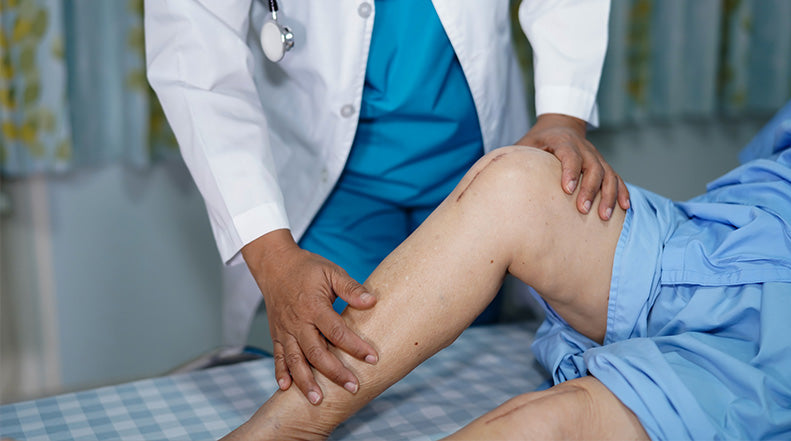Treating a Knee Replacement Scar

Knee replacement, also called arthroplasty, is a surgical procedure performed to resurface the knee joint in order to alleviate knee pain and disability. According to Johns Hopkins Medicine, the most common condition that results in the need for knee replacement surgery is osteoarthritis. Other conditions that warrant knee replacement surgery are rheumatoid arthritis, an autoimmune disease, and traumatic arthritis, which is arthritis due to injury.
Knee replacement surgery requires the surgeon to make a vertical incision on the top of the knee to expose the damaged area. Then, the surgeon removes the damaged surfaces of the knee joint and resurfaces the knee joint with the prosthesis, which is made up of metal and plastic. The prosthesis mimics the movement of the natural knee.
The standard incision size for a knee replacement can be as long as 10 inches, but a minimally invasive procedure can result in incisions as short as 4 inches. Since the incision is very long and deep, scarring will occur after a knee replacement as part of the body’s wound healing process.
SCAR FORMATION AFTER KNEE REPLACEMENT
Like any surgery, the body begins a complex process to heal the wound after a knee replacement. Wound healing is achieved through four precise and highly programmed phases: hemostasis, proliferation, inflammation, and tissue remodeling. (J Dent Res. 2010) Hemostasis means to stop the flow of blood, which is accomplished when the doctor closes the incision with stitches, metal staples, or a combination of both. Another technique is to use stitches internally followed by surgical glue to close the uppermost layer of skin.
The next step in the wound healing process, proliferation, means that the cells around the wound begin multiplying rapidly. The margins around the wound grow and migrate inwards toward the base, uniting at the center in order pull the wound shut.
Inflammation is a normal part of the wound healing process, which occurs as the body recruits macrophages (a type of immune cell) to clear away damaged cells and begin the tissue remodeling process. Inflammation will appear as redness and slight swelling in the wound area.
The final stage of wound healing is tissue remodeling, a complex process that can last anywhere from several months to years. In this stage, macrophage cells transition to a reparative state that stimulates keratinocytes (skin cells), fibroblasts (connective tissue cells), and angiogenesis (the development of new blood vessels) to begin tissue regeneration. (J Dent Res. 2010)
Fibroblasts grow into granulation tissue where they produce collagen, a structural protein, to support the newly formed tissue. While collagen is necessary to seal the wound, if the body produces too much collagen a raised, discolored scar can result. These can either be hypertrophic scars or keloids. Both are raised and red, but the feature that distinguishes keloids from hypertrophic scars is their growth past the original scar boundary. Keloids can turn from red to brown, and often have a lumpy appearance. Left untreated, keloid scars can continue to thicken and grow indefinitely.
Scar tissue is different from normal skin; it will be a different texture and it will also lack elasticity. This means that during the healing process, the scar must be elongated enough in the remodeling phase to allow full knee flexion to occur. According to Livestrong, as the scar becomes fully formed, continuation of the stretching program set up by the physical therapist is essential to keep the scar from contracting so much that it limits knee flexibility and mobility.
THE BEST TREATMENT FOR KNEE REPLACEMENT SCARS
Now that you know how scars form after a knee replacement, you’re probably wondering what to do to minimize scarring after your surgery. There are a plethora of creams and lotions in drugstores that all claim to help with scarring. The problem with these products is that they have not been tested for efficacy or safety. This means you’d be buying a product that may or may not work, and actually may cause more harm than good.
So what is the best treatment for knee replacement scars? Clinical studies have shown that silicone gel and sheeting are considered the first-line therapy to manage and minimize scarring, including scars after knee replacement. In fact, silicone gel products are the only topical treatments recommended by the scar experts who create scar treatment guidelines for other doctors.
NewGel+ offers the widest variety of silicone scar treatment products available. For example, the 2” x 8” silicone strips fit perfectly over knee replacement incisions. In addition to therapeutic stretching, early treatment with silicone gel is crucial after knee replacement to prevent contracture and to maintain flexibility and mobility over joints.
Take the first step toward enjoying life with your new knee by browsing the NewGel+ product collection now.
Knee replacement, also called arthroplasty, is a surgical procedure performed to resurface the knee joint in order to alleviate knee pain and disability. According to Johns Hopkins Medicine, the most common condition that results in the need for knee replacement surgery is osteoarthritis. Other conditions that warrant knee replacement surgery are rheumatoid arthritis, an autoimmune disease, and traumatic arthritis, which is arthritis due to injury.
Knee replacement surgery requires the surgeon to make a vertical incision on the top of the knee to expose the damaged area. Then, the surgeon removes the damaged surfaces of the knee joint and resurfaces the knee joint with the prosthesis, which is made up of metal and plastic. The prosthesis mimics the movement of the natural knee.
The standard incision size for a knee replacement can be as long as 10 inches, but a minimally invasive procedure can result in incisions as short as 4 inches. Since the incision is very long and deep, scarring will occur after a knee replacement as part of the body’s wound healing process.
SCAR FORMATION AFTER KNEE REPLACEMENT
Like any surgery, the body begins a complex process to heal the wound after a knee replacement. Wound healing is achieved through four precise and highly programmed phases: hemostasis, proliferation, inflammation, and tissue remodeling. (J Dent Res. 2010) Hemostasis means to stop the flow of blood, which is accomplished when the doctor closes the incision with stitches, metal staples, or a combination of both. Another technique is to use stitches internally followed by surgical glue to close the uppermost layer of skin.
The next step in the wound healing process, proliferation, means that the cells around the wound begin multiplying rapidly. The margins around the wound grow and migrate inwards toward the base, uniting at the center in order pull the wound shut.
Inflammation is a normal part of the wound healing process, which occurs as the body recruits macrophages (a type of immune cell) to clear away damaged cells and begin the tissue remodeling process. Inflammation will appear as redness and slight swelling in the wound area.
The final stage of wound healing is tissue remodeling, a complex process that can last anywhere from several months to years. In this stage, macrophage cells transition to a reparative state that stimulates keratinocytes (skin cells), fibroblasts (connective tissue cells), and angiogenesis (the development of new blood vessels) to begin tissue regeneration. (J Dent Res. 2010)
Fibroblasts grow into granulation tissue where they produce collagen, a structural protein, to support the newly formed tissue. While collagen is necessary to seal the wound, if the body produces too much collagen a raised, discolored scar can result. These can either be hypertrophic scars or keloids. Both are raised and red, but the feature that distinguishes keloids from hypertrophic scars is their growth past the original scar boundary. Keloids can turn from red to brown, and often have a lumpy appearance. Left untreated, keloid scars can continue to thicken and grow indefinitely.
Scar tissue is different from normal skin; it will be a different texture and it will also lack elasticity. This means that during the healing process, the scar must be elongated enough in the remodeling phase to allow full knee flexion to occur. According to Livestrong, as the scar becomes fully formed, continuation of the stretching program set up by the physical therapist is essential to keep the scar from contracting so much that it limits knee flexibility and mobility.
THE BEST TREATMENT FOR KNEE REPLACEMENT SCARS
Now that you know how scars form after a knee replacement, you’re probably wondering what to do to minimize scarring after your surgery. There are a plethora of creams and lotions in drugstores that all claim to help with scarring. The problem with these products is that they have not been tested for efficacy or safety. This means you’d be buying a product that may or may not work, and actually may cause more harm than good.
So what is the best treatment for knee replacement scars? Clinical studies have shown that silicone gel and sheeting are considered the first-line therapy to manage and minimize scarring, including scars after knee replacement. In fact, silicone gel products are the only topical treatments recommended by the scar experts who create scar treatment guidelines for other doctors.
NewGel+ offers the widest variety of silicone scar treatment products available. For example, the 2” x 8” silicone strips fit perfectly over knee replacement incisions. In addition to therapeutic stretching, early treatment with silicone gel is crucial after knee replacement to prevent contracture and to maintain flexibility and mobility over joints.
Take the first step toward enjoying life with your new knee by browsing the NewGel+ product collection now.




Comments